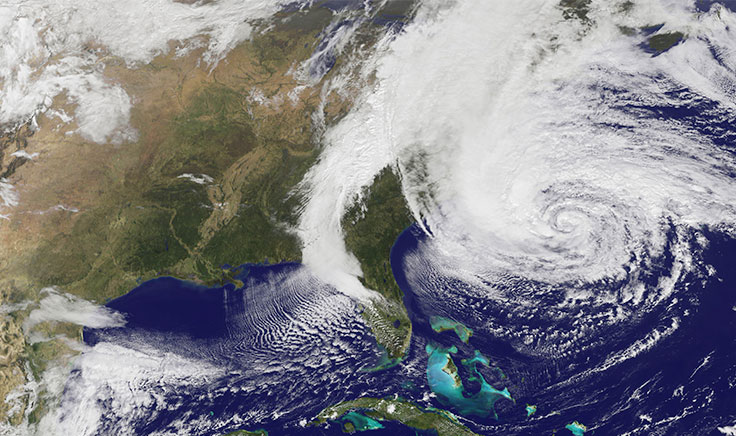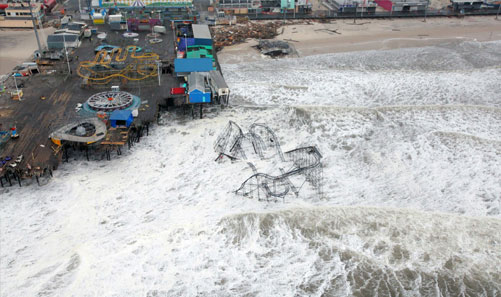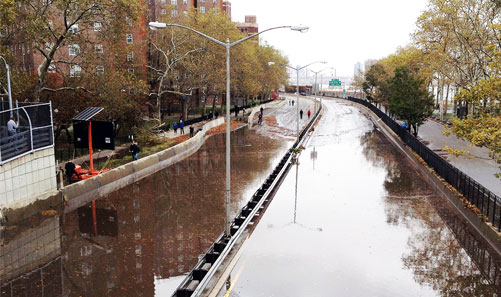Flood Zones

Flood Zones
Living in a NYC Flood Zone
What's a flood zone and does it really matter if you're living in one? Given the significant damage wreaked by Hurricane Sandy in 2012 in neighborhoods of Lower Manhattan, Red Hook and the Rockaways, it's definitely worth considering before moving into an apartment or home located along one of New York's waterfronts. And if you're buying property, it means that any mortgage you receive will require purchasing flood insurance. Here are the basics covering the New York City flood zones and the things to take in consideration if you decide to buy or rent there.
How a Flood Zone Is Determined
New York flood maps are determined by the Federal Emergency Management Agency, better known as FEMA. FEMA's Flood Insurance Rate Maps (FIRMs) are determined by mapping the topography of the city as well as the types of storm strengths that have historically hit New York. Areas are then rated a high risk for flooding and waves, a high risk just for flooding, moderate risk or no risk. These zones, however, may be in flux. FEMA hasn't significantly updated its maps since 1983 and is currently working on new FIRMs for New York, expected to be released next year.

Where the Flood Zones Are
As you might guess, anywhere along a New York waterfront ranks high for flood risk. But the risks of flooding have changed post Sandy and may reach further than you think. FloodHelpNY offers maps with the current risk and how it is expected to change with new maps in 2017. Flood Zone NYC is more comprehensive, as the map “was born out of a frustration with the official NYC hurricane evacuation zone tool.” (It also comes as a phone app.) This simplified map shows evacuation zones in purple, as well as locations in each borough to evacuate to if necessary.
At-Risk Neighborhoods for Flooding
What are the worst neighborhoods to live in when it comes to flood risk? According to the maps, the Lower Manhattan waterfront is at high risk for evacuation, including neighborhoods like the South Street Seaport, Tribeca, Battery Park City, and the eastern and western waterfronts through Upper Manhattan. (The evacuation zones, however, decrease as you move uptown.) Significant portions of Staten Island, along the western and eastern waterfront, are at risk. In Brooklyn, the South Brooklyn waterfront shows the most risk, including Red Hook, Brighton Beach and Howard Beach. In Queens, the Rockaways rate as the highest risk for evacuation.

Renting in a Flood Zone
Flood insurance is not required when you move into a rental apartment located in a high-risk flood zone. Even if you decide to purchase renter’s insurance, flooding is typically not included in coverage -- you will need to talk to your insurance agent about your flooding risk and if you’d like to pay extra to include that coverage. It’s also a good idea, if you’re moving into a neighborhood at risk for flooding, to speak with building management about their flood plan. Are the building mechanicals located above ground, reducing the risk that a building will lose power if it floods? Is there a backup generator? What should happen if the building does lose power for a prolonged period of time? Be sure you have a plan in place before any flood risk arises.
Buying in a Flood Zone
Homeowners insurance does not cover flooding. But under the National Flood Insurance Act, mortgage lenders require that borrowers whose property is located within a Special Flood Hazard Area purchase flood insurance as a condition of receiving federally-regulated mortgage loans. A standard flood policy covers structural damage, like damage to the furnace, water heater, air conditioner, floor surfaces and debris clean-up. But your actual belongings are not covered under a standard policy -- that’s going to cost extra. Flood insurance roughly costs, according to FEMA, $500 a year, although it depends on your risk level and the amount of coverage you choose.

If a Hurricane Hits
Once you know your flood zone, make a plan. You'll find lots of pointers on how to do this at the NYC Emergency Management's site Know Your Zone. If you're living with the highest risk for flooding, be sure you have a place to go in case city officials tell you to evacuate during a storm. The city recommends to stay in the loop through signing up for Notify NYC, New York's official source for information concerning emergency events.

 6sqft delivers the latest on real estate, architecture, and design, straight from New York City.
6sqft delivers the latest on real estate, architecture, and design, straight from New York City.
